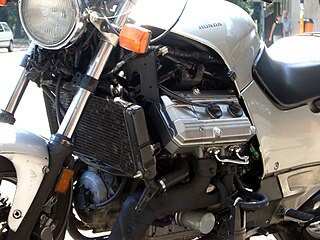Related Research Articles

American Motors Corporation was an American automobile manufacturing company formed by the merger of Nash-Kelvinator Corporation and Hudson Motor Car Company on May 1, 1954. At the time, it was the largest corporate merger in U.S. history.

A V4 engine is a four-cylinder piston engine where the cylinders share a common crankshaft and are arranged in a V configuration.

The AMC Javelin is an American front-engine, rear-wheel-drive, two-door hardtop automobile manufactured by American Motors Corporation (AMC) across two generations, 1968 through 1970 and 1971 through 1974 model years. The car was positioned and marketed in the pony car market segment.

The Ford 335 engine was a family of engines built by the Ford Motor Company between 1969 and 1982. The "335" designation reflected Ford management's decision during its development to produce a 335 cu in (5.5 L) engine with room for expansion. This engine family began production in late 1969 with a 351 cu in (5.8 L) engine, commonly called the 351C. It later expanded to include a 400 cu in (6.6 L) engine which used a taller version of the engine block, commonly referred to as a tall deck engine block, a 351 cu in (5.8 L) tall deck variant, called the 351M, and a 302 cu in (4.9 L) engine which was exclusive to Australia.

The Willys F4-134 Hurricane was an inline-4 F-head piston engine that powered the M38A1 military Jeep in 1952, followed by the famous Jeep CJ in the CJ-3B, CJ-5, and CJ-6 models. It was also used in the Willys 473 and 475 pickups, wagons, and sedan deliveries. It replaced the Willys Go Devil engine that was used in the MB Jeep and other early Jeep-based models like the Jeepster. This engine was also built by Mitsubishi for their license-built Jeep, for other applications.

The Dodge Monaco is an automobile that was marketed by the Dodge division of Chrysler Corporation. Introduced as the flagship of the Dodge product line, the Monaco was introduced for the 1965 model year to replace the Custom 880, then later joined as a sub-model of the Dodge Polara. During its production, the Monaco was offered in several body configurations, including two-door and four-door hardtop sedans, four-door sedans, two-door convertibles, and station wagons.

The AMC Hornet is a compact automobile manufactured and marketed by American Motors Corporation (AMC) from 1970 through 1977—in two- and four-door sedan, station wagon, and hatchback coupe configurations. The Hornet replaced the compact Rambler American line, marking the end of the Rambler marque in the American and Canadian markets.

The AMC V8 may refer to either of two distinct OHV V8 engine designs developed and manufactured by American Motors Corporation (AMC) starting in 1956. These engines were used in cars and trucks by AMC, Kaiser, and International Harvester, as well as in marine and stationary applications. From 1956 through 1987, the automaker equipped its vehicles exclusively with AMC-designed V8 engines.

The AMC straight-6 engine is a family of straight-six engines that were produced by American Motors Corporation (AMC), and used in AMC passenger cars and Jeep vehicles from 1964 through 2006. Production continued after Chrysler acquired AMC in 1987.
The Computerized Engine Control or Computerized Emission Control (CEC) system is an engine management system designed and used by American Motors Corporation (AMC) and Jeep on 4- and 6-cylinder engines of its own manufacture from 1980 to 1990. It is one of the three major components for proper engine operation: the computer, electrically controlled carburetor, and the oxygen sensor in the exhaust system.

The AMC Matador is a series of American automobiles that were manufactured and marketed by American Motors Corporation (AMC) across two generations, from 1971 through 1973 (mid-size) and 1974 until 1978 (full-size), in two-door hardtop and coupe versions, as well as in four-door sedan and station wagon body styles.

Weber Carburetors is an automotive manufacturing company founded in 1923, known for their carburetors.

The SJ series Jeep Cherokee is a full-size SUV that was produced from 1974 through 1983 by Jeep. It was based on the Wagoneer that was originally designed by Brooks Stevens in 1963.
The Quadrajet is a four barrel carburetor, made by the Rochester Products Division of General Motors. Its first application was the new-for-1965 Chevy 396ci engine. Its last application was on the 1990 Oldsmobile 307 V8 engine, which was last used in the Cadillac Brougham and full size station wagons made by Chevrolet, Pontiac, Oldsmobile, and Buick.

The Mercury Cyclone is an automobile that was marketed by the Mercury division of Ford from 1964 to 1971. Introduced in 1964 as the Mercury Comet Cyclone, the Cyclone replaced the S-22 as the performance-oriented version of the Mercury Comet model line. The Cyclone became a distinct nameplate for the 1968 model year, as the Mercury Montego was phased in to replace the Comet.
Renix was a joint venture by Renault and Bendix that designed and manufactured automobile electronic ignitions, fuel injection systems, electronic automatic transmission controls, and various engine sensors. Major applications included various Renault and Volvo vehicles. The name became synonymous in the U.S. with the computer and fuel injection system used on the AMC/Jeep 2.5 L I4 and 4.0 L I6 engines.

The Autolite 4300 was a four-barrel carburetor manufactured by Autolite in multiple variants from 1967 through 1974. Used by both Ford and AMC, it was produced as an emissions-compliant replacement for the previous Autolite 4100 model, and was superseded by the Motorcraft 4350.

The Motorcraft 2150 is a Ford 2-barrel carburetor manufactured from 1973 through 1983, based heavily on its predecessor, the Autolite 2100 carburetor.
A feedback carburetor is a specific type of carburetor made mostly during the 1980s to improve emissions on certain vehicles in the US.
References
- ↑ "Autolite 2100 carburetor". www.mustang-s.com.
- ↑ "Classic Inlines - Selecting the right carburetor for your inline six". fordsix.com.
- ↑ 'Ford Autolite Carburetors' URL: https://www.hemmings.com/stories/article/ford-autolite-carburetors Hemmings
- ↑ 'Autolite 2100 AMC '68-74 Jeep '71-74 rebuild kit [AK4128]' URL: https://classiccarbs.com.au/index.php?route=product/product&path=482_253_482_270_250&product_id=3549 | Classic Carburetors Australia